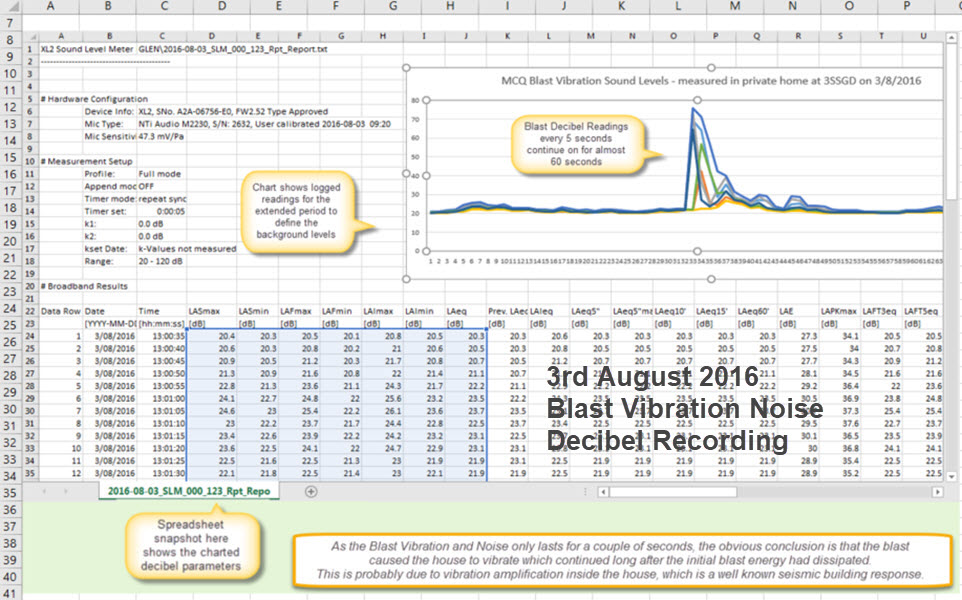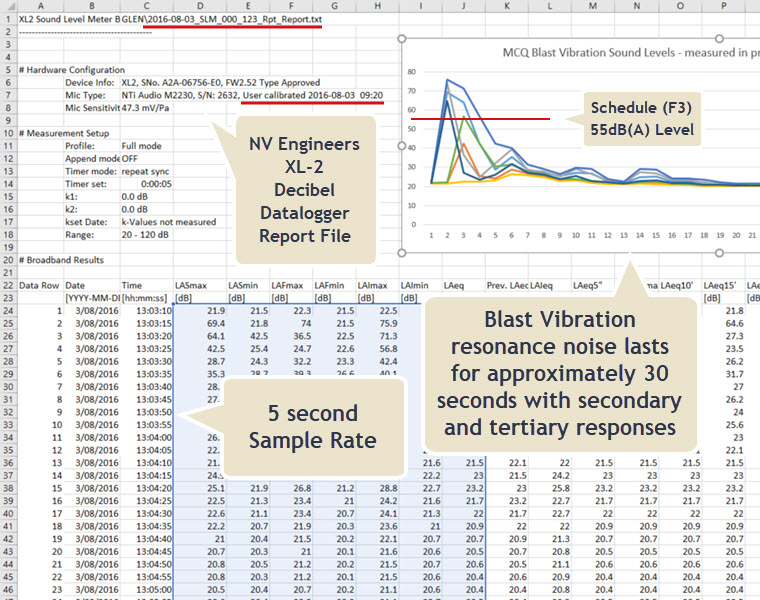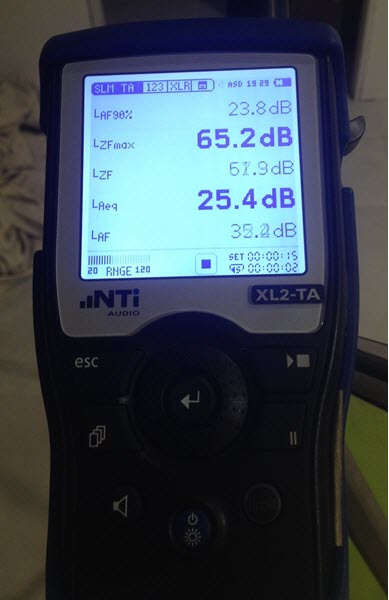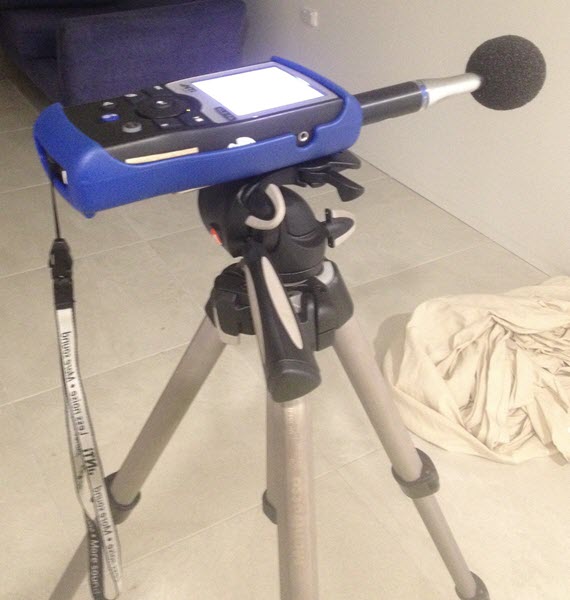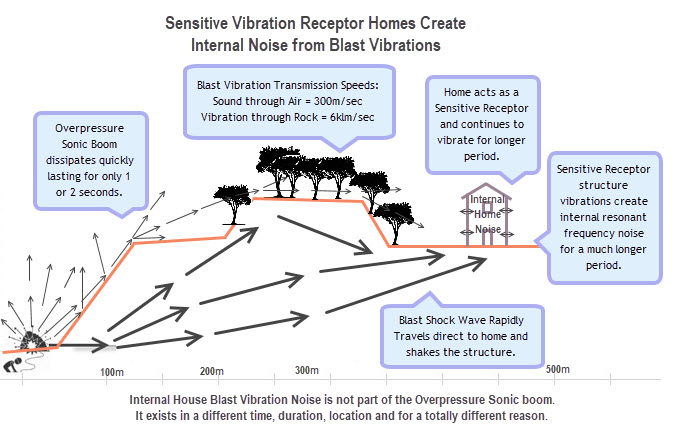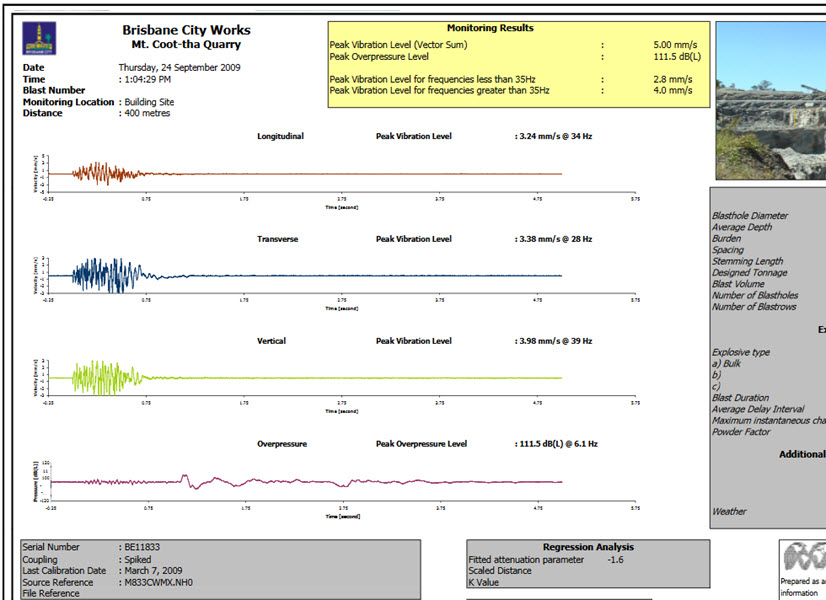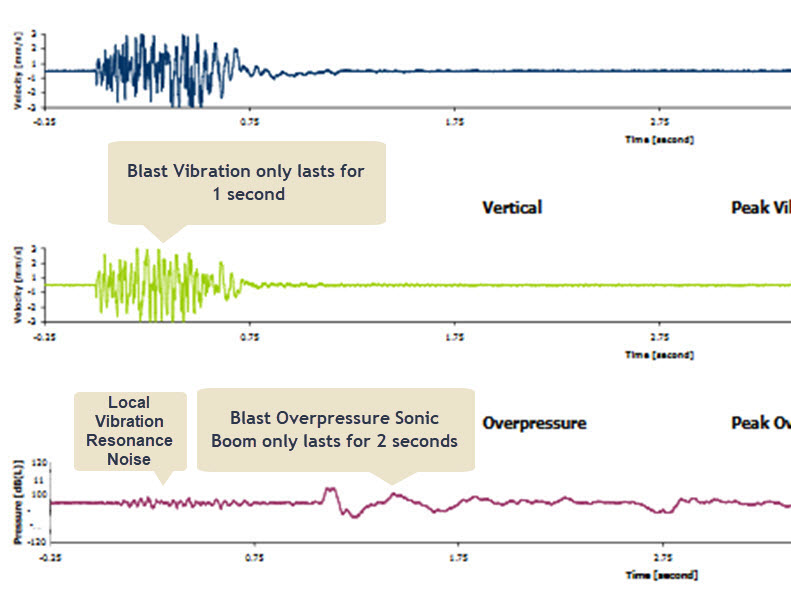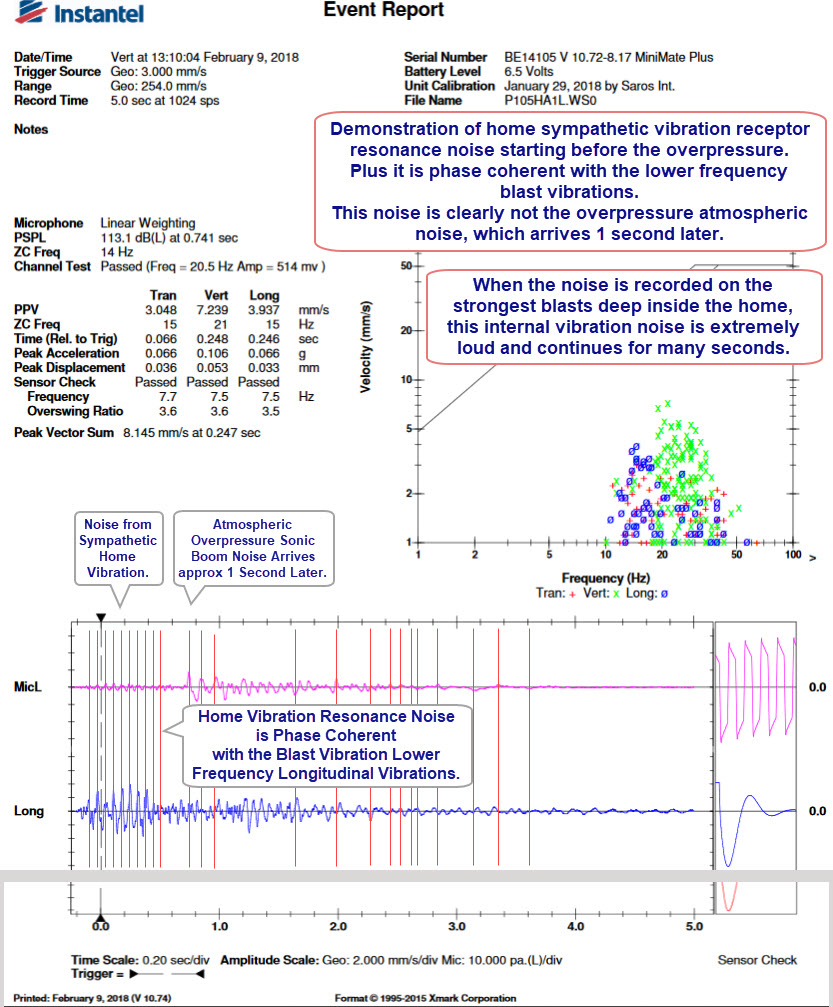Mt Coot-tha Quarry - Blast Noise Decibels In Private Homes.
24th September 2009 (MCQ Data) Quarry Blast.
3rd August 2016 Quarry Blast.
Defined XL-2 Decibel Datalogger Usage Process.
Legal Validity of Private Home Noise Measurements.
Characteristics of Overpressure (Sonic Boom) Noise.
Building Vibration Noise Duration/Time Period Characteristics of Overpressure (Sonic Boom) Noise.
Comparing Overpressure Noise with Building Blast Vibration Noise.
MEASURING Overpressure Noise with Building Blast Vibration Noise.
Building Vibration Sensitive Receptor Resonance Noise Summary.
Blast Noise Regulation Summary.;
24th September 2009 Blast
On the 24th September 2009, Dr Heilig conducted a blast vibration monitoring process on the private land at #3SSGD (3 Sir Samuel Griffith Drv).The results of this blast was later provided to the property owner, which included a graphical timeline display of blast vibrations and noise.
Upon analysing the noise decibel display, we were able to determine that an earlier noise existed, which was not the later sub-audible low-frequency Overpressure Atmospheric effect.
This local noise arrived in synchronisation with the actual blast vibrations and clearly preceeded the overpressure effect.
Upon further analysis of this noise, it became apparrent that it could not possibly be any overpressure, which has a much longer wavelength, slower transmission speed and almost double the distance travelled.
Using the chart is was possibe to zoom in, to display and measure the amplitude of the local noise.
The EDO Lawyers had previously provided a signed statement confirming that this noise is relevant to the BCC MCQ EA Schedule F1-F5 compliance conditions.
These conditions are defined in Table-1, which states a maximum noise level of the Ambient Decibels + 5 Decibels.
This timeline chart display created by Dr Heilig, clearly indicated that the noise level grossly exceeded the Schedule F Table-1 maximum allowed.
Hence the BCC provided data clearly indicates that the BCC MCQ noise level does indeed greatly exceed the allowed maximum.
The Local Residents have always regarded this as a noise which is coincident with the actual blast vibrations, and which sounds like a bomb explosion actually inside the private dwelling homes.
Many other MCQ blast vibration timeline charts show the same features, in fact the non-overpressure noise is actually shown to be phase-coherent (in step with) the actual blast vibrations.
3rd August 2016 Quarry Blast
On the 3rd August 2016 the Mt Coot-tha Quarry did a very strong blast that was measured as 10.38mm/second at the 159MCR monitoring point.On that same day the Local Residents hired a NATA approved and calibrated XL-2 noise decibel datalogger from NV Engineers in Camp Hill.
The datalogger was used to record the noise inside a local resident's private home, and the recorded decibel levels indicate that the home continued to vibrate for more than 30 seconds after the blast.
The local residents data extrapolation seem to indicate that on that blast that the vibrations in the home reached a level above 20mm/second.
The actual numeric level shown on our spreadsheet is 25.75mm/second, which is consistent with the (small sample size) measured Median Home/159MCR value of 2.48.
Note: However as stated before, this value is only approximate and is to be used as an indication that a professional statistics report is required, pending further investigation by the governments.
Defined XL-2 Decibel Datalogger Usage Process
We recommend hiring a professional decibel datalogger, provided by an RPEQ Mechanical Engineer. We also recommend that the installation engineer is either a Senior Professional Electrical Engineer "SPEE" or any type of RPEQ Engineer.We used the XL-2 NATA approved decibel datalogger from NV Engineers in Camp Hill Brisbane.
1. The RPEQ engineer calibrates the datalogger on the morning before the blast.
2. The RPEQ engineer inputs the settings that are suitable for the noise measurement.
3. The installation SPEE takes the datalogger from the RPEQ and places it at the recording site as directed by the RPEQ (swithed on and in record mode).
4. The installation SPEE ensures that all windows are closed and that there is no outside sources of noise. (In this case the windows are double glazed.)
5. The installation SPEE ensures that no person, animal or other noise source is present in or outside the private home during the recording period.
6. After the blast, the installation SPEE, switches the datalogger off and returns it to the RPEQ engineer.
7. The RPEQ engineer checks and downloads and the decibel data from the XL-2 datalogger into his or her computer.
8. The RPEQ engineer analyses the data and emails the loged data to the Local Resident Customer and other recipients.
Note: The intention being to provide this data to the governments, to enable them to more accurately comply with all regulations.
The Legal Validity of Private Home Noise Measurements
Certainly the above procedure may well be acceptable to a magistrate, even if the installing SPEE is the private home owner, so long as the SPEE can certify that nobody or no animals were inside or near the home at the time of the blast.Because both the blast monitor and the datalogger are closely linked to the time of day, plus the actual generated decibel waveform shape should be reproducable on any future occasion, then the possibility of any tampering with the data is extremely unlikely.
The Mt Coot-tha Quarry MCQ-EPPR has two noise classifications: 1. Overpressure Sound and 2. All other sound.
Characteristics of Overpressure (Sonic Boom) Noise
The MCQ-EPPR states the folowing: " (F4) Noise emanating from blasting operations must not exceed an over-pressure level of 125dB (linear Peak) for more than ten percent (10%)... etc. ...Wikipedia definition is Atmospheric: Overpressure is the pressure caused by a shock wave over and above normal atmospheric pressure. The shock wave may be caused by sonic boom or by explosion, etc...
Hence the overpressure is a form of sonic boom. There is no doubt that this is a purely atmospheric condition, caused by the fast rushing gas and air moving away from a blast explosion.
Overpressure Noise Duration/Time Period Characteristics
Looking at the September 2009 Mt Coot-tha Quarry Blast Trace, you can see clearly on the enlarged-view blast trace that the overpressure noise trace has a rumble noise which is coincidential with the blast vibration caused by the ground shaking and then half a second later the overpressure noise arrives and lasts for approximately one second.There are some possible reflections, however within two seconds the noise has all been dissapated.
Building Vibration Noise Duration/Time Period Characteristics of Overpressure (Sonic Boom) Noise
Looking at the August 2016 Decibel Datalogger report and the associated enlarged-view chart, you can see that the samplig rate is set to 5 seconds.The duration of the noise clearly lasts over several samples for a time of approximately 20 or 30 seconds.
The noise is generated when the building acts as a sensitive receptor and resonates with the blast vibrations shaking the floor and walls and has nothing to do with the overpressure.
Comparing Overpressure Noise with Building Vibration Noise
When comparing the 2 charts it is obvious that the building resonance noise lasts for much longer period than the overpressure noise, and the measured home blast vibration seems to be around double the strength of that measured beside the road an 159MCR.When the blast vibration travels through the ground, it hits the building and makes the building vibrate. This sensitive receptor causes a noise to be generated inside the house has no relationship to any atmospheric or overpressure concept.
The residents believe that is impossible to classify the blast vibration resonance response as anything at all to do with the overpressure, for these reasons.
1. The blast vibrations cause the building to resonate in sympathy with the frequencies of vibrational energy transmitted through the ground and then into the building.
2. The blast vibration building resonance noise is not an atmospheric response, it is scientifically a totally different effect.
3. The duration of the blast vibration building resonance noise far exceeds, is far stronger and much more severe than that of simple overpressure.
4. The energy levels in a one or two second blast overpressure which has had to diffract out of the hole, through the trees and up over the hill, is very unlikely to have either the energy level or the phase coherence required, to ever cause building resonance which lasts for some seconds.
Measuring Overpressure Noise against Building Vibration Noise
BCC Data Used: John Heilig Instantel Minimate Blast Vibration Monitor timeline chart.Measurement Location: #3SSGD (aka 159MCR) building Site 400metres from the blast zone.
Blast Date Recorded: 24th September 2009.
Notes:
1. The timeline chart clearly shows the three blast vibration axes as recorded by the Instantel Minimate Tri-axial transducer.
2. It also shows the decibel levels recorded by the Minimate microphone.
3. All four amplitude traces use exactly the same timeline axis.
4. Atmospheric overpressure noise is reduced by the general air attenuation, solid angle, distance from the blast, diffraction effects through trees and finally the actual building walls.
5. It is possible that the local internal home noise is much louder than the outdoor overpressure noise.
About Overpressure Instantel Microphone Measured Noise:
1. The Microphone Overpressure Decibel chart shows the Overpressure noise arriving approximately one second after the ground vibrations, because of the much slower atmospheric sound propagation speed & frequency, plus the longer aerial transmittion path.
2. Hence any noise that arives before the one second delay cannot possibly be technically considered as Overpressure, because it is impossible for the atmosphere to deliver the sound at the same velocity and frequency as the seismic ground vibrations.
3. The Decibel chart clearly shows the low 6Hz frequency which is typical of Overpressure Shockwave sonic boom noise.
About Building Vibration Instantel Microphone Measured Noise:
4. When studying the decibel timeline, it is obvious that there is indeed a higher frequency noise which exists before the Overpressure, this can only then be due to the noise coming from the ground or structures which is caused by the blast ground vibrations as measured by the tri-axial transducer.
5. When expanding the timeline and vertical chart axes, it is possible to visually see that the decibel and vibration amplitudes have phase coherence.
6. In addition to this, the 6Hz Overpressure only lasts for aproximately 3 seconds as the primary airblast and all possible reflections are dissipated.
7. Hence the noise which exists for the first one second of the blast, as well as that which lasts more than 4 seconds after the blast cannot possibly be overpressure airblast sonic boom noise.
About Building Vibration AE-2 Decibel Datalogger Measured Noise:
8. It is possible to locate a decibel datalogger inside the private homes, this has a frequency response designed to capture house vibratin noises.
9. This decibel datalogger recorded the internal home noise both before and after the arrival of the of the outdoor overpresure noise.
10. This internal home noise is therefore not constrained by the EA Schedule-F conditions which "provide for" overpressure noise.
Conclusions:
1. The noise recorded by the internal home decibel datalogger was not overpressure, because the timeline, frequency and phase coherence are impossible with Overpressure noise.
2. Whilst there may have been residual overpressure noise at the time, the energy from the ground vibrations entering the home is considerably stronger.
3. The internal home decibel trace is not any overpressure response and is hence covered by the EDO Legal Advice Decision Number 2, for non-overpressure noise.
4. There exist a "Local Vibration Noise" loud noise which arrives almost at the same time as the gound vibrations.
5. The cause of this noise is the sympathetic vibration movement of ground connected objects as the result of the blast vibrations transmitted through the ground.
6. This is the noise that all the residents hear in their homes and sounds like a bomb going off. This is highly intrusive and extremely frightening (especially for Children). This is the situation that Schedule-F noise conditions are clearly designed to prevent.
7. When considering the decibel amplitudes, it is possible to see that these significantly exceed those as defined in the MCQ EA Schedule-F for non-overpressure noise.
8. The Minimate timeline comparison is likely to be visible on many Minimate decibel timelines, however it is not normally considered as important because ordinarily there is are defined 500m and 1000m separation exclusion zones which do not exist at Mt Coot-tha.
9. However at MCQ there is zero separation zone to the local residents homes, plus the Schedule-F conditions were originally written some decades ago.
10. The original location for the #3SSGD 3rd August 2016 Decibel Datalogger Recording was initially defined by the MCQ Manager in September 2009 and again in November 2011, as all comparisons had to be at the same address.
Operational Limitations:
1. The MCLR are never advised of the estimated blast strength, even though they have asked 16 times to be provided with any kind of estimate.
2. The exact timing of the blast is never provided, so the MCLR do not know the blast setup progress and the shot-firing time.
3. The MCLR are only advised of the blast one or two days before and are never advised of the cancellation.
4. Hence the MCQ has deliberately made it financially unviable to both book and pay for an accoustic consultant to attend each proposed blast on short notice.
5. The process followed as well as the qualifications and experience of the MCLR Chairperson are documented in correctly administered Statutory Declarations.
6. The actual operation simply involves switching on the metre, and leaving the building. After the blast the datalogger is switched off and returned to the supplier who then provides the data.
7. The DES has criticised the process used, but never suggested any re-recording or attendance or measurement by their staff.
Building Vibration Sensitive Receptor Resonance Noise Summary
1. The blast vibration building resonance noise can never be defined as the 6Hz Overpressure noise airblast and covered by overpressure related Schedule-F conditions.2. To put it simply: The residents have always believed that the home blast sensitive vibration receptor resonance noise is not and never could be an atmospheric pressure wave driven effect.
3. The sensitive vibration of the homes is caused by the Ground Vibrations and is subject to the conditions of the Schedule-F general noise for both personal and commercial buildings.
4. The private home will resonate due to the effects of the ground vibration energy, this will emit loud noise inside the homes which is coincident with the blast vibration feeling.
5. The Persistence of the internal home vibration will depend on the initial blast vibration energy level, and may persist for some seconds afterwards.
6. Current technology computer and video hard drives are highly likely to be damaged by such blast vibrations, but only if they are executing a read or write cycle at the time of the blast.
Blast Noise Regulation Summary
The MCQ-EPPR Schedule F (Noise) defines 2 types of noise, General noise and Blasting noise. Item F2 has both a Condition and a Regulation.Condition F2 states "Except as provided for during blasting operations the emissions of noise from the approved place must not result in levels greater than those specified in Table 1 of the Noise Schedule".
1. The Blasting noise regulations are F4 and F5 are Only concerned with Overpressure Noise.
2. Because the noise inside the homes is not overpressure noise, as provided for during blasting operations" fails and is thus not applicable.
- The longer lasting sensitive ground vibration receptor resonance noise inside the homes "is not provided for" in F4 and/or F5 and hence these two conditions do not apply.
- Hence the Schedule F noise inside (Brisbane City Council Approved homes), is only covered by the general noise limit which states a maximum of 5dB above ambient.
In addition to this regulation F3 is not conditioned and is therefore always applicable.
The residents believe that:
1. The general noise limit exists to protect residents in their own homes from noise disturbance, and the August 3rd 2016 blast noise exceeds this limit by a massive 70dB.
2. The August 3rd blast noise seems to also exceeds regulation F3 by approximately 20dB.
3. Both AS2187.2 Appendix J and BS7384 (whilst they are old) are both focussed in protecting buildings and people from harm.
4. The 5dB above ambient noise level is exceeded inside the homes on almost every blast, and on some blasts the F3 55dB(A) condition is also exceeded.
5. Some Local Residents say that inside their homes when a blast above 6mm/second hits, is like a bomb going off inside your home.
6. There does not seem to be any reason why the accuracy of this recording could be anything other than highly accurate. Given the exact same conditions, it should be repeatable.
Top of Page
24th September 2009 (MCQ Data) Quarry Blast.
3rd August 2016 Quarry Blast.
Defined XL-2 Decibel Datalogger Usage Process.
Legal Validity of Private Home Noise Measurements.;
Characteristics of Overpressure (Sonic Boom) Noise.;
Building Vibration Noise Duration/Time Period Characteristics of Overpressure (Sonic Boom) Noise.
Comparing Overpressure Noise with Building Blast Vibration Noise.
MEASURING Overpressure Noise with Building Blast Vibration Noise.
Building Vibration Sensitive Receptor Resonance Noise Summary.
Blast Noise Regulation Summary.
